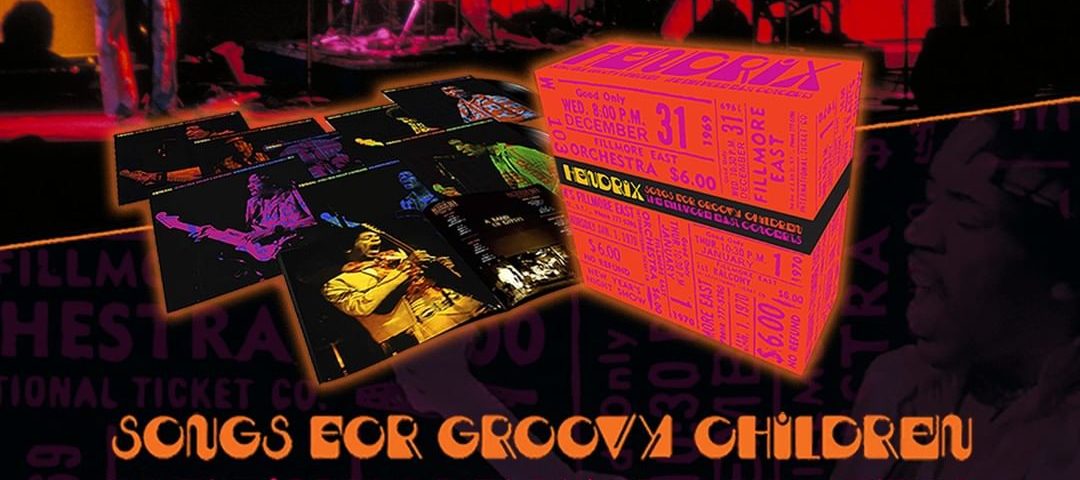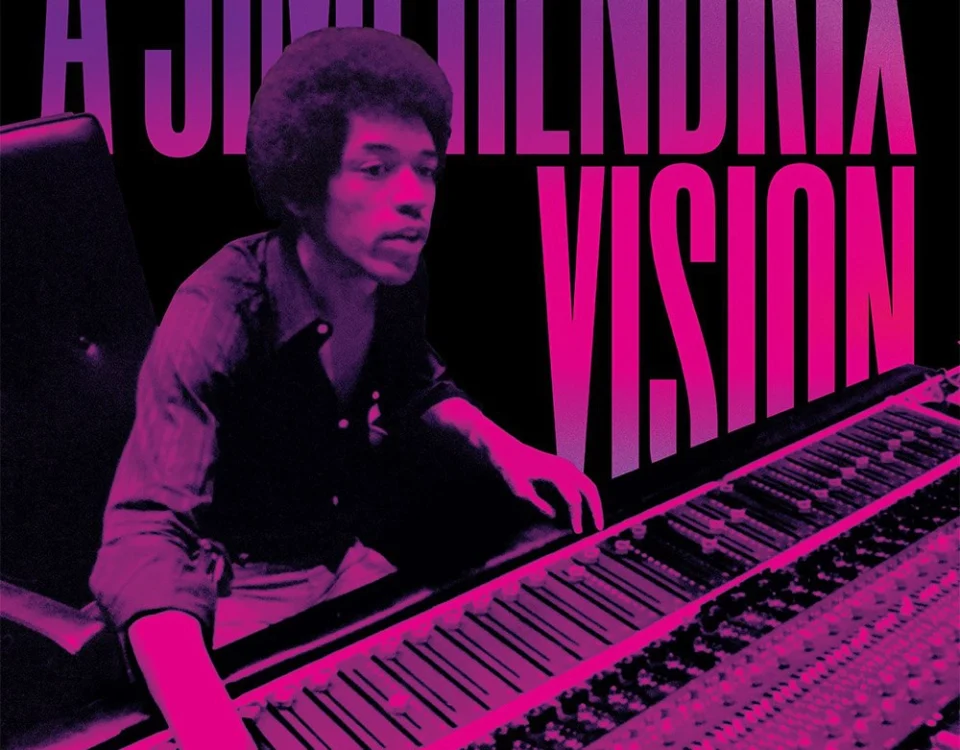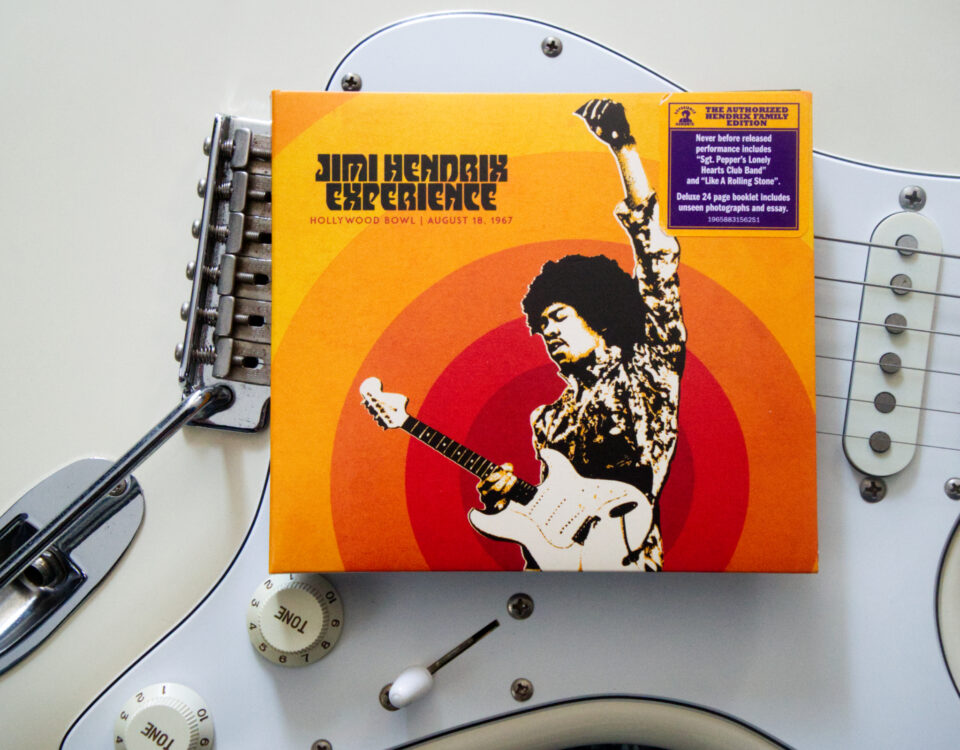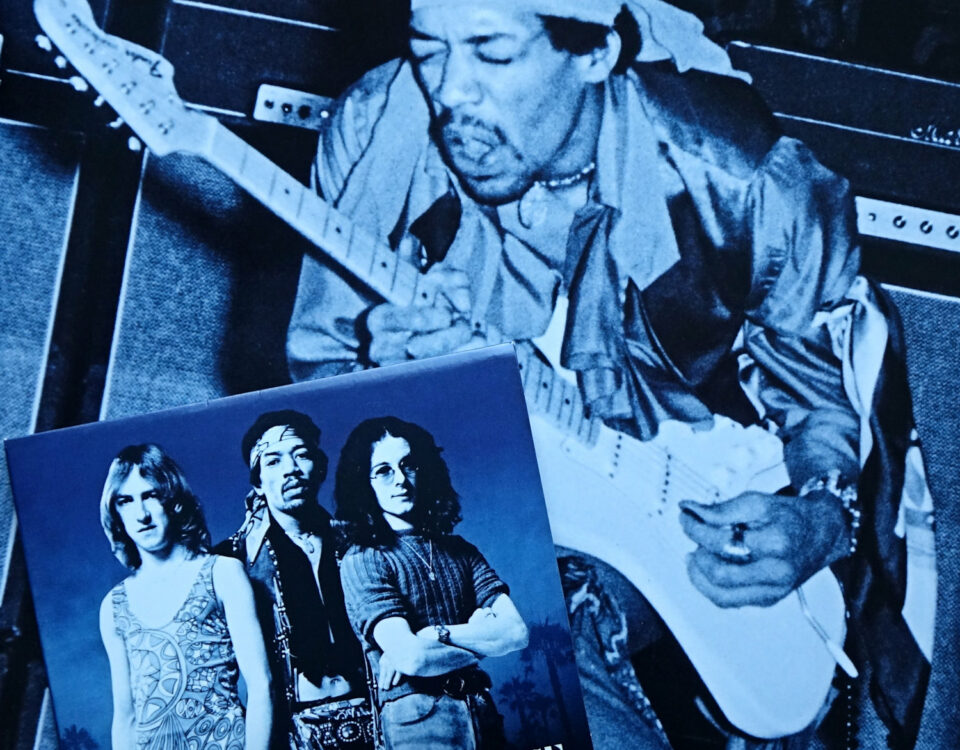CHAPTER TWENTY-TWO: GROOVY GYPSYS AND MISSING CHILDREN

© Frank Moriarty, 2020
The mission of this next free chapter of Modern Listener Guide: Jimi Hendrix seemed crystal clear – at first. Just take a deep dive into Songs for Groovy Children, the massive box set released late in 2019 focusing on Band of Gypsys, Jimi Hendrix’s short-lived trio with Billy Cox on bass and Buddy Miles on drums. But then Experience Hendrix – as they’ve been known to do – threw a monkey wrench into those blissfully simple plans.
Mere weeks after issuing that weighty box set retrospective, Experience Hendrix announced their intention to further mine Band of Gypsys gold. On March 27, 2020, a remastered, repackaged, repressed, and reissued 50th anniversary edition of the original Band of Gypsys album was launched into the marketplace – one suddenly reeling from the virus threatening the entire globe.
While that release may have flown into music retailers somewhat under the radar given current circumstances, it does signify (almost) the conclusion of Experience Hendrix’s concentration on this group over the last six months.
So, it seems like a good time for a chapter assessing this vast aural landscape. Let’s dig in!
First, though, a quick reminder – these free supplemental chapters have a more conversational and less formal format than the chapters that make up Modern Listener Guide: Jimi Hendrix. For a good look at the printed book’s tone and approach, you can click up top on the link titled Inside the Book. There you’ll find a healthy sampling of actual book content extracted from “Chapter Eleven: ‘We’re Just Jamming, That’s All.’” This material sets up and analyzes Jimi Hendrix’s performance with the Gypsy Sun and Rainbows band at Woodstock. But here in the bonus chapter realm, things are more casual, though certainly no less in depth.
THE BACKSTORY – ASSEMBLING A BAND OF GYPSYS
As thoroughly analyzed in Modern Listener Guide: Jimi Hendrix, several months after his landmark Woodstock gig in summer 1969 Jimi Hendrix was without a band, and creatively adrift. Yes, he was indulging in his habit of burning chargeable time in recording studios, but the tracks laid down were not to his satisfaction, and an overall sonic vision for his immediate future was murky at best. Billy Cox, arguably Jimi’s closest musician friend, sensed this fundamental dissatisfaction, as did another of Jimi’s close friends, drummer Buddy Miles. The two began to think that what Hendrix needed was something immediate and creative to look forward to, something that could sweep away this suffocating air of malaise. The remedy became Band of Gypsys.
The sensation of a fresh start was happily compounded when, early in December 1969, looming drug charges in Canada were dismissed with a verdict of not guilty during a trial in Toronto. The possibility of a lengthy jail sentence had weighed on Jimi’s mind for much of the year.
With high spirits Hendrix’s new trio began serious rehearsals that same month in a small facility in Manhattan known as Baggy’s Studios. The creative work undertaken had a sense of urgency: concert dates were on the near horizon. The new group was booked by Bill Graham into his Fillmore East venue on Second Avenue near East 6th Street in the Lower East Side for two shows to see out 1969 on New Year’s Eve and two more on New Year’s Day to welcome in 1970.
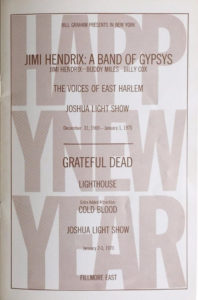
Bill Graham’s Fillmore East program from the last week of 1969 indicated a very busy week was in store.
The group, now christened Band of Gypsys, was to play more than a creative role in the affairs of Jimi Hendrix; there was an urgent practical aspect as well. Jimi had signed an ill-advised contract with New York producer Ed Chalpin in his pre-fame days of 1965. Now that Jimi was a star, Chalpin was demanding compensation. After intense legal wrangling Hendrix’s label, Warner Brothers, had agreed to allow Chalpin to release the fourth Jimi Hendrix album of new material, through an alliance Chalpin set up with Capitol Records. The Hendrix camp considered a live album of new songs to be the quickest and cheapest means of fulfilling the obligation to Chalpin. Arrangements were made to record all four Fillmore East shows with the goal of extracting a single-disc live LP from the tapes.
Beyond the Fillmore gigs, Band of Gypsys would survive for just one more show: a disastrous appearance at the Winter Festival for Peace benefit at Madison Square Garden on January 28, 1970. An aborted performance led to the trio’s abrupt dissolution.
The existence of Band of Gypsys was not without its controversy. At the time, Hendrix manager Mike Jeffery was not pleased with the new lineup from a financial futures perspective, believing the work spent building the brand “Jimi Hendrix Experience” was now being thrown away.
From a musical standpoint, Band of Gypsys was a different animal than the Experience, and the difference was heard in more than just the new material Hendrix was developing. The drumming styles of Buddy Miles and Experience drummer Mitch Mitchell were a study in contrasts. Mitchell’s hallmark was a busy, roiling, jazz-influenced attack. Where Mitchell’s drumming would often feel like he was challenging Hendrix, Miles was all about rock-solid time, largely staying out of the way but able to change the entire feel of a song through a subtle adjustment of his tactics. Locked down with bassist Billy Cox, Miles would deftly set up changes with microburst fills or simple accents that did not depend on showy flourishes. Over the decades Hendrix fans have been known to argue over which drummer was better suited to work with Jimi; there’s certainly nothing wrong with recognizing that Mitchell and Miles each had their own percussive musical charms.
While the Band of Gypsys story concluded with a gig best forgotten, the four Fillmore East shows preceding that Madison Square Garden disaster offered up a number of fundamental works of imposing music significance. This is the focus of Songs for Groovy Children, its title adapted from a remark made by Hendrix from the stage of Bill Graham’s legendary theater.
SONGS FOR GROOVY CHILDREN – WHAT IT IS…
Released on November 27 in the carefree pre-pandemic early winter of 2019, Songs for Groovy Children appears as either a five-disc CD set in a 5.25 x 5.5-inch box, or a hefty LP-sized box containing eight records. The audio content is identical in both variations. The booklet content and layout – including a rambling essay by Nelson George and a remembrance by Billy Cox – is largely the same, though the CD printing does have three photos that do not appear in the LP version. Of course, the booklet is far more enjoyable in the larger presentation, and one of the shared photos is found uncropped in the big format. The photographs that appear in both booklets include fascinating images captured at a Fillmore East soundcheck and backstage at the venue.
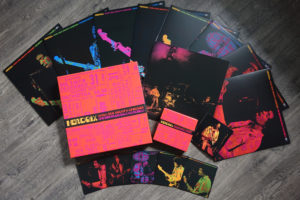
The colorful wealth of content found within the CD and LP boxes of Songs for Groovy Children.
It feels odd to be writing about a new Jimi Hendrix box set in which the vast majority of its content – and arguably its most shimmering highlights – have already been commercially issued hither and yon on a variety of preceding releases. But that’s where we find ourselves with this title. Of the 43 tracks presented by Songs for Groovy Children, just 13 have not been commercially released in the past. Obviously, this new material is incredibly welcome. The press release announcing the collection expanded on this by boasting of more than two dozen tracks that have “either never before been released commercially or have been newly pressed and newly remixed.”
The idea of a complete presentation of the four Fillmore East shows has long been on the radar screens of dedicated Hendrix fans. In fact, fans took matters into their own hands late in the 1990s, assembling the Box of Gypsys compilation, piecing together the four sets using soundboard recordings and audience tapes.
Like many things in the Hendrix realm, the devil is definitely in the details – in this case a brewing controversy over which tapes provided which sources for Songs for Groovy Children. And a kerfuffle has reached a boiling point over whether Band of Gypsys played a particular version of “Burning Desire” in the first or second show on New Year’s Day 1970. For a deeper analysis of all these aspects, I refer you to issue 118 of the hallowed Jimi Hendrix publication Jimpress. For the purposes of this chapter, though, let’s step out of the minutiae quagmire and take a more “holistic” listen to this box set.
After all, holistic is defined as the “comprehension of the parts of something as intimately interconnected and explicable only by reference to the whole.” And Songs for Groovy Children gathers (nearly) the whole of the output of Band of Gypsys in a unified presentation.
Wait… What? Nearly?
Well, before there can be holistic listening there has to be collation – and here’s where Songs for Groovy Children falls short before the sounds even get started. “Collation” is defined as “collect and combine in proper order,” and that order is disrupted by a disturbing vacuum, one created by a whopping five songs that are missing in action – nearly ten percent of the Band of Gypsys output at Fillmore East.
Supposedly, these songs were “too flawed” to be included in this set, either due to technical or tuning issues. Throughout his career, examples of Jimi straying out of tune in concert are abundant – as are examples of the guitarist tuning “on the fly” to bring things back into pitch. But these Band of Gypsys performances are so flawed that they can’t be included in a supposedly complete box set? It makes you wonder if they were actually recorded.
Ah, but they indeed were, and I just listened to them while writing this chapter. All five come from the late show on New Year’s Eve. And all five are part of the renowned Box of Gypsys, the ultimately more-complete, fan-created documentation of the trio’s history that’s been circulating in trader circles for decades (though as we will see later in this chapter, a compilation itself missing two previously-unknown performances happily included on Songs for Groovy Children).
So, what can be heard in those five songs? Just how flawed are they? I’m glad you asked!
THE MISSING – SONGS PLAYED BY BAND OF GYPSYS YET NOT INCLUDED
The first of the missing songs is “Stepping Stone,” appearing third on the set list of the New Year’s Eve late show, slotted after a rambling “Who Knows” previously released on Live at the Fillmore East.
The track opens with brittle clean guitar, and almost immediately Buddy Miles is chasing the breakneck pacing. In fact, Miles can do little more than act as a timekeeper, so frantic is the tempo Jimi sets from the beginning. Another song with unsettled lyrics at this point in its development, “Stepping Stone” finds Hendrix slurring words and lines where a final determination has yet to be made. Lyrics aside, Jimi brings an aggressive edge to his soloing which clearly communicates his greater confidence in the instrumental passages than in the vocals.
“Stepping Stone” was played just one more time during the Band of Gypsys run at the Fillmore East, during the early show on New Year’s Day. That version was later included on Live at the Fillmore East.
Immediately following “Stepping Stone” was “Burning Desire,” which had closed the trio’s first set on this New Year’s Eve. As we now know, this late show version will remain officially unreleased, though it’s really not apparent why. The performance is reasonably tight, with the trio in unison easily slowing its pace when required, fully reaccelerating later. After this section Jimi appears to make the decision to cut the song short. This abrupt ending may have been cause for the song to be left off Songs for Groovy Children. But in truth this finale is actually interesting – it works, and the variation reflects the occasional spontaneity of these shows.
“Ok, we’re going to play something else,” Jimi then announces, retreating to the relative safety of “Fire.” That early Jimi Hendrix Experience hit was followed by “Ezy Ryder” and “Machine Gun,” before the Band of Gypsys took on the next missing song, “Power of Soul,” being performed for the second time that night.
Jimi takes a long intro solo which works well, brimming with intensity, before dropping into the funky first verse. Like many of the Band of Gypsys originals, this song was presented with fluid lyrics, but this performance is certainly no less focused than a number of other tracks from these shows selected for official release. Miles and Cox sync up with Hendrix on the late song ascension, and the track manages a controlled landing shortly thereafter, ultimately punctuated by the sound of Hendrix sliding his hand down the neck of his Stratocaster. “We didn’t finish that one yet,” Jimi then admits somewhat sheepishly, but this rendition is far from a train wreck. If anything, the loose feel of much of this material gives it charm.
This set closed with two of Jimi’s most popular songs, “Voodoo Child (Slight Return)” and “Purple Haze,” both also banished from Songs for Groovy Children. The former is notable for a particularly fierce solo climax colored by skronky Octavia notes, while the familiar parameters of the latter are charged with live-performance excitement. It may not be the tightest version of “Purple Haze” Hendrix ever played, but it’s far from the most chaotic. Is Buddy’s scat-singing along with Jimi’s closing notes the disqualification for this performance? Well, it does place the close of this rendition firmly in “unique” sonic territory.
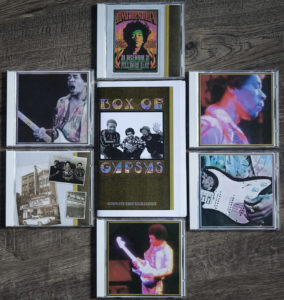
The fan-created Box of Gypsys. Though lacking two new discoveries found on Songs for Groovy Children, in the big picture it still retains its title as “the most complete Band of Gypsys collection.”
The first three tracks from the New Year’s Eve late show that are missing from Songs for Groovy Children are heard as quite listenable soundboard recordings on the unofficial Box of Gypsys. That compilation also includes the last two missing songs, though rougher sounding for having been captured on a tape recorder in the audience – an audience obviously thrilled by the performance that they had just witnessed.
The inclusion of these songs would have been preferable to leaving gaping holes in the lineup of Songs for Groovy Children. A reference in the box set booklet could easily have offered a simple explanation: “Though the sound quality of these five songs doesn’t match the rest of this box set, the goal of completely documenting these musically historic shows justifies their inclusion.” That would have neatly excused the relative sonic deficiency.
The failure to take this action is even more puzzling in light of the less-than-pristine audio of the September 14, 1968, Hollywood Bowl show inexplicably selected as a core component of the 50th anniversary Electric Ladyland box set of 2018. If those roughly-recorded live songs sounded good enough to be released, so, too, do these.
Is anyone’s life going to go unfulfilled by not hearing these songs? Surely not. Admittedly, there is nothing to be heard that is truly jaw-dropping. But it is Jimi Hendrix live in concert, and this material should be treated with respect and appreciation for its historical significance. Of course, Experience Hendrix are no strangers to revising history, as we’ve seen with Larry Lee’s missing tracks from their 1969 Woodstock compilation or the presentation of the “complete” 1970 Atlanta International Pop Festival release which conveniently omits the very last song, Jimi’s aborted attempt at playing “Hey Baby (New Rising Sun).”
Alas, we are not quite finished with what is missing on Songs for Groovy Children. During the late show on New Year’s Day, Hendrix, Cox, and Miles apparently played versions of both “Foxy Lady” and “Stop” that do not appear on this box set – or anywhere else, for that matter. These songs have never turned up on any known recordings in current circulation. These tracks are, however, listed in an inventory of Band of Gypsys tape reel contents provided by the Museum of Pop Culture, perhaps better known among Hendrix enthusiasts in an earlier incarnation as the Hendrix-focused Experience Music Project, an entity created by Microsoft founder Paul Allen. So, it appears these songs were actually played that long-ago night at Fillmore East, but for now – forever? – they will remain missing in action.
THE UNHEARD – BAND OF GYPSYS SONGS RECEIVING A FIRST OFFICIAL RELEASE
And now we move on to a more pleasant topic than picking over what is missing, as we investigate a long-awaited bounty of wonderful new sounds from Band of Gypsys.
In the relatively recent years before Songs for Groovy Children, listeners had been given a clearer perspective of the breadth of the Band of Gypsys experience thanks to two double-CD releases: the compilation Live at the Fillmore East and Machine Gun: The Fillmore East First Show 12/31/1969.
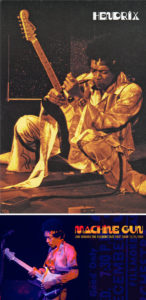
Live at the Fillmore East (top, 1999) and Machine Gun: The Fillmore East First Show 12/31/1969 (bottom, 2016) both helped cultivate a demand among listeners for the expanded Band of Gypsys release Songs for Groovy Children.
This broader perspective included examples like the version of “Machine Gun” performed at the late show on New Year’s Eve, first released on Live at the Fillmore East. Many of the components inhabiting the ultimate version of the song as heard on 1970’s Band of Gypsys – aspects that make it so haunting and compelling – are also heard here. But they emerge in an unfocused fashion, reflected by moments including Jimi’s somewhat hesitant attempt to find the melody of “Taps” on his fretboard, a task which he mostly completes – eventually. In the end, this earlier rendition is basically a lot of interesting sounds strung together, in a form that is still somewhat disjointed.
Of course, all of the material on those earlier CD releases is fully repeated on Songs for Groovy Children. And though this box set may provide a new context for those performances, there is really no need to re-review everything issued in the past; all of these tracks are covered in detail in the print and e-book editions of Modern Listener Guide: Jimi Hendrix.
Fortunately, the amount of songs new to commercial release thanks to Songs for Groovy Children is sizeable, and the excitement surrounding this material makes them well worth a detailed analysis in this chapter. Ironically, the New Year’s Eve late show – the very show represented on Songs for Groovy Children without five performances – also provides the bulk of these new Band of Gypsys tracks.
The first of these songs is “Fire,” a dependable hit from the Experience which Jimi chose to insert fairly early in this late show. This rendition comes hot on the heels of the new year’s arrival, heralded via a celebratory “Auld Lang Syne,” an expansive “Who Knows,” and two of the missing songs, “Stepping Stone” and “Burning Desire.” While the drumming of Buddy Miles perfectly complements the funkier aspects of Band of Gypsys, in the context of “Fire” Miles’ steady approach is sorely lacking the tightly controlled chaos of Mitch Mitchell. Buddy just takes things straight ahead, and as a result the musical flames never really erupt. Jimi keeps his solo short, his Stratocaster’s tone far cleaner than usual on this song. He does indulge in what would become a common feature of later renditions of “Fire,” slyly slipping the riff to Cream’s “Outside Woman Blues” into the proceedings. However, the nod to the recently dissolved power trio is not made more effective by Miles’ decision to scat-sing a duet with Hendrix’s guitar work.
After “Fire,” the crowd – emboldened by the presence of an early Experience hit – feels emboldened to yell out for their favorites. Jimi, however, has other ideas.
“Man, we’re just jamming right now. Is that alright with you?” he asks, making it clear that he’s going to lead the band in a new direction. His introduction of “Ezy Ryder” that follows does not sound particularly confident: “We’ll see if we can get that together here…”
Sure enough, the new song quickly proves to be problematic.
Jimi launches into the first verse and promptly forgets what he wants to sing after the opening lines. He’s forced to lead Cox and Miles through an instrumental progression, biding time until the trio can circle back around for another swipe at the verse. This time things are more successful from a lyrical perspective. Regardless, it’s the instrumental portions of “Ezy Ryder” that are most impressive; this new song has a challenging arrangement that Jimi and his Gypsys navigate with what feels like a growing confidence, even if the song’s ending is best described as “abrupt.”
That new song is followed by one of the four versions of “Machine Gun” played at the Fillmore concerts, this show’s iteration previously released two decades ago on Live at the Fillmore East. In its wake came the “missing” performance of “Power of Soul,” before Songs for Groovy Children picks up the set list again for five straight songs, beginning with “Stone Free.”
Jimi plays it fairly safe with this early Experience song, at least until he reaches an extended instrumental section. He announces its arrival with a strenuous tremolo bar workout that leads to a cascade of notes crowned by a hectic chromatic ascent up the Stratocaster neck. Hendrix hovers here among the higher notes before dropping into a two-note octave section that finds him curiously toying with the melody of “The 1812 Overture.” Closing the bag of tricks for now, it feels as though Jimi is ready to bring the focus back to “Stone Free” with a spirited run to the climax. Instead, he begins to drift through assorted progressions, including a brief flirtation with the then-unreleased instrumental “Cherokee Mist.” Eventually Cox and Hendrix lay out, yielding the stage to the never-shy Miles, who takes his time working through a lengthy drum solo. Things teeter on the verge of falling apart as the guitar and bass reemerge, but the rhythm section simplifies its foundation and Hendrix then leads a journey through everything from pseudo-flamenco flourishes to a quick dabble in The Beatles’ “I Feel Fine.” Obviously, Jimi’s bag of tricks is wide open again. The guitarist makes use of both wah-wah pedal and Octavia to restate portions of “Cherokee Mist,” then abandons those passages to merge into snippets of Cream’s “Sunshine of Your Love.” Somehow this all leads back into “Stone Free” and a familiar path to the song’s finale.
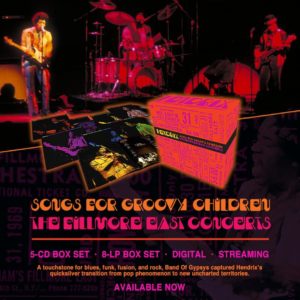
Attractive and effective advertising characterized the release of Songs for Groovy Children.
Next on the list is the welcome simplicity of Buddy Miles’ spotlight song, “Changes.” This version gets a relaxed treatment through the opening verse, a vibe that continues until Jimi enters the solo section with a slightly frantic intensity and a high-speed tumble down his Stratocaster’s fretboard. But less than 30 seconds later Hendrix has stepped back, retreating into support mode as Buddy characteristically begins a long rap about all the changes he’s going through. Jimi and Billy soon urge the drummer to wrap things up by insistently building a throbbing pulse, but Buddy fails to get the hint and his two bandmates eventually give up the prodding. This encourages Miles to enter into an even longer audience interaction. At last, there’s a most welcome return to the song’s main structure, crowned with a long and energetic Miles drum roll around his kit to set up the closing chord.
Immediately following “Changes,” the Woodstock festival set opener “Message to Love” sets out on a jaunty note. The trio sounds fully confident with this song, one that is still largely unfamiliar to the audience. The brisk pace finds Hendrix deciding to explore a shorter-than-usual instrumental segment coming out of the first verse and chorus. Following the next set of lyrics, there’s an unusual entry into the vocal call-and-response break, with Buddy halting suddenly and Billy offering a few tentative notes. The three players sort things out, quickly if not seamlessly, then move on into the concluding instrumental passages. Throughout this section Jimi is not so much soloing as he is deploying intriguing examples of his myriad rhythm guitar techniques. As the end nears Hendrix contributes to the urgent surge of Miles and Cox, and the trio rides together to the song’s concluding ascent, its peak wrapping up a compact version of this track.
The New Year’s Eve late show continues with the r&b chestnut “Stop,” written by Jerry Ragovoy and Mort Shuman in 1967 and first recorded by Howard Tate. Intense, aching notes from Jimi’s guitar herald the song, but the Band of Gypsys quickly settle into a coy, light-funk vibe that retains much of the easy strut of the song’s original version. The rendition played at this show is the longest of the three scattered through Songs for Groovy Children. Early on Hendrix offers a powerful but playful solo after trading vocals with Buddy in the chorus following the opening verse. In the next opening for a solo, Jimi – as he had done in the preceding “Message to Love” – once again focuses on funky rhythmic aspects. He caps this excursion with a shimmering climb up his Strat’s neck, mixing hefty bends with single note staccato picking.
On Songs for Groovy Children this New Year’s Eve late show closes in pleasantly lumbering fashion with the Experience’s reliable hit, “Foxy Lady” (though as discussed earlier, “Voodoo Child (Slight Return)” and “Purple Haze” were the actual final songs). True to form, Buddy Miles’ drumming on “Foxy Lady” is no more flamboyant here than elsewhere. But his basic style now syncs far more successfully on this Experience song than on faster-paced pieces like “Fire,” songs which relied heavily on Mitch Mitchell’s hyper-propulsive skills. The song plays out in extended form, offering plenty of musical turf for typical Hendrix firepower. There are a handful of less-than-stellar guitar moments, no doubt byproducts of Jimi pulling out all the stops from a showmanship perspective. After all, Hendrix’s primary focus was playing for the crowd in front of him; what was captured on tape was of immediate secondary concern. There is no dramatic conclusion to the song: the trio eventually just plays softer and softer, Jimi thanking the audience before the Band of Gypsys simply come to a full stop.
The next show the group played – the early show on New Year’s Day – provides two more of the newly released songs. “Changes” made the set list at all four shows, while “Earth Blues” from this set was the trio’s third and final attempt at the song during the Fillmore East run.
Like the other three versions of the song played across these gigs, this particular “Changes” is nearly identical to its brethren. In fact, the main differentiation between any of them is measured by how long Buddy Miles subjects everyone to tales of woe, demands supportive clapping, or seeks vocal assistance from the audience. To some in the crowd, it may have begun to feel like a hostage situation.
“Earth Blues” is more refreshing and interesting. Yet, despite having received dedicated attention during the Baggy’s Studios rehearsal sessions, the “Earth Blues” played at this third Band of Gypsys show is a victim of Hendrix’s inability to decide on and memorize a single set of lyrics. Jimi forgetting his lyrics – or improvising replacements on the spot – characterized many of the new songs taken on by Band of Gypsys. And songs worked on by the trio in these shows were later recorded with any number of further lyrical revisions. But once again, the music comes to the rescue. This performance is elevated by a series of howling notes that populate the song’s solo – even if one or two seem to be in a key other than the one “Earth Blues” itself inhabits. The song closes with Jimi ominously wielding his UniVibe to craft a wildly pulsing build to the song’s finale.
Two more previously unreleased tracks were recorded during the Band of Gypsys’ final show in the Fillmore East run. In fact, these two songs were the climax of the evening.
“Hey Joe” finds Hendrix reaching back to some of his earliest material, playing the song that became his first single in the UK soon after his migration to London in 1966. Here the well-worn song structure gets a fairly straightforward reading, the band adhering closely to the song’s original road map.
They try to do the same with “Purple Haze,” at least until Jimi manages to forget the words to the second verse. Hendrix takes it out on his Stratocaster, manhandling the guitar. Underneath, Billy follows the basic chord progression without embellishment and Buddy pounds a relentless beat. As the trio circles around to the song’s final lyrics, it’s obvious that Hendrix’s abuse has pummeled his low E string into a seriously out-of-tune condition, necessitating some on-the-fly adjustments. Jimi’s quick action saves the day, and the band brings the hardy performance to a successful conclusion, punctuated by some exaggerated whooping in celebration from Buddy.
THE UNKNOWN – BAND OF GYPSYS PERFORMANCES PREVIOUSLY UNKNOWN
Box of Gypsys was long regarded by collectors as the most complete documentation of Hendrix, Cox, and Miles in action at the Fillmore East. But the late 2019 announcement of Songs for Groovy Children quickly offered proof that tape traders seldom have access to everything. Two Band of Gypsys performances completely unknown to mortal consumer ears were revealed to be part of the box set: a version of Hendrix’s own “Lover Man” and a cover of “Steal Away.”
The fourth Band of Gypsys show hosted these surprise songs, performances known only to those who were actually at the Fillmore East that long-ago night or to those who’ve since had access to the master tapes. The two songs were played fairly deep in this longest set of Fillmore East shows, and appear in consecutive order on Songs for Groovy Children. It should be noted this is a conflict with the master tape inventory list provided by Museum of Pop Culture mentioned earlier in this chapter; according to that list “Stop,” “Earth Blues,” and “Foxy Lady” separated these mystery tracks, placing them as the sixth and tenth songs of the set. To add to the confusion, “Stop” and “Foxy Lady” are the final-show songs missing not only from Songs for Groovy Children, but from any known circulating recordings, also detailed earlier in this chapter. Be that as it may, the emergence of these two previously unknown tracks was exciting news indeed.
Up first, “Lover Man,” is a song familiar to just about anyone with a deeper interest in the career of Jimi Hendrix. The guitarist had an ongoing fixation with the composition. More than 50 known versions of it exist, with the first attempts at recording the song dating back as far as spring 1967. Though the song frequently haunted Hendrix’s live concert set lists from 1968 on, in the studio Jimi never seemed to polish it to his satisfaction despite many attempts with various personnel arrays. Here, having played the song during the first Fillmore East show, he returns to it in this last show, turning in a short, tight version driven hard by his clean-tone rhythm guitar work.
If the revelation that Jimi included “Lover Man” in this final set isn’t exactly stunning, “Steal Away” is more of a shocker, receiving its one and only in-concert performance at the hands of Hendrix. Written and performed in 1964 by Jimmy Hughes, this solid r&b song had also been taken on by Etta James in 1968. Over a year later, Band of Gypsys made the surprising – and perhaps somewhat spontaneous – decision to incorporate Hughes’ composition into their final show at the Fillmore East.
“Buddy Miles is going to sing a slow blues!” Jimi exclaims, and that’s an accurate description of the Band of Gypsys interpretation of “Steal Away.” Following Jimi’s emotive bent notes serving as a musical introduction, the trio slows the pace considerably from the tempo of the original version. Traditional in structure and in the trio’s approach to it, the song offers Hendrix an opportunity to deploy selections from his vast catalog of blues stylings. It’s certainly a treat to hear Jimi deftly navigate through the simple changes, casually utilizing sparkling accents interspersed with thrilling runs across his Strat’s fretboard.
FINAL THOUGHTS – SOME OLD FRIENDS IN A BRAND-NEW BOX
As described at the beginning of this chapter, Songs for Groovy Children is available in either five-CD or eight-LP box set editions. A shared design perspective flavors both editions visually, vibrant colors reflecting the music’s promise and artistically-treated ticket memorabilia reflecting dates and location.
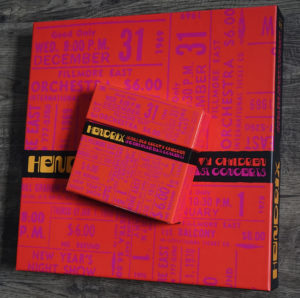
Yes, I managed to get all that “stuff” back inside the Songs for Groovy Children external boxes. And in the proper order, too.
The sound quality throughout Songs for Groovy Children is everything you could hope for. As mentioned earlier, Hendrix’s guitar equipment was building on the already-imposing sonic foundation of his Woodstock tone. The glorious aural palette at Jimi’s disposal ranged from sparkling clarity to roaring distortion, and it is presented here in riveting fashion. Indeed, Hendrix’s monolithic guitar tones at these Fillmore East shows join his performances at Woodstock in 1969 and Berkeley in 1970 as the very culminations of his restless quest for maximum sonic impact. Billy Cox’s bass is full and supple, a reliable and occasionally inventive deep pulse at the heart of every performance. And Buddy Miles’ drum sound is very well recorded – from the deep pump of his bass drum to the warm snap of his snare – making the drummer’s unerring sense of time all the more effective.
In most cases, what’s on the tape is what is heard on Songs for Groovy Children: one moment might offer careless, aloof vocals, the next astonishing instrumental brilliance. This full-length approach to the presentation will be good news for those who can’t get enough of the scat singing of Buddy Miles. For everybody else, it’s a case of taking the over-the-top along with the good.
Still, in the interest of historical accuracy – and aside from the known missing five songs – it’s important to note Songs for Groovy Children is not really a complete presentation of the Fillmore East shows. The box set’s official announcement hype may have implied it was complete, and later promotional material from retail outlets and reviews by music writers boldly used the “complete” word, but there are edits throughout this box set, and some are substantial. Yet at the same time it must be pointed out that some previously released songs appear here as longer versions subjected to less editing. Did someone mention a tangled web? In the end, editing can be considered an artistic tool, with judicious snipping leading to a more listenable end product. But if the goal is to offer a complete documentation, obviously editing becomes a detrimental action.
Clarity remains elusive when taking into account contradictory statements like this one from Experience Hendrix producer/engineer Eddie Kramer, published in the January 2020 issue of Uncut magazine: “Some tracks were cut — whether we did that for technical or musical reasons, I won’t get into. We had to do a few cleanups when someone dropped a bollock but you want to protect the instant and the flow. The whole intention of this box is to put it out the way it was, warts and all. The fans want to hear every note no matter how wonky.”
Say, Eddie – aren’t “cleanups” the polar opposite of a “warts and all?” You can’t have both…
Once again, you are directed to Jimpress – issue 117 specifically – for a detailed breakdown of these manipulations. Will you then listen to this set in a state of eternal yearning knowing what material was excised? Certainly not. But there is the valid argument that such a massive endeavor as Songs for Groovy Children appeals specifically to the most dedicated fans of Jimi Hendrix’s music, the very market that would be most forgiving of (and interested in) the moments selected to be edited out.
Still, taken on its own there is no disputing the fact that Songs for Groovy Children is a worthwhile collection boasting hours of fascinating moments. It’s just that, as with other Experience Hendrix projects in years past, a perfect release with contents impossible to quibble with was well within their grasp.
Peering into the past, it’s important to recognize the contrasting motives behind the creation Band of Gypsys in 1970 and Songs for Groovy Children in 2019. Decades ago, Eddie Kramer and Jimi Hendrix were seeking to create an album with chart potential, one that cherry-picked many of the finest moments of Band of Gypsys in concert. Their goal was to edit together a cohesive listening experience. Songs for Groovy Children – while not quite as “warts and all” as Eddie Kramer insisted late in 2019 – seeks to document the concert experience of Band of Gypsys across all four shows played at the Fillmore East. Steering mostly clear of the perfection-seeking editing that Hendrix and Kramer dedicated to the six tracks of the original Band of Gypsys album, Songs for Groovy Children more honestly celebrates this trio for what they actually were: a fascinating, sometimes sloppy, and sometimes brilliant experiment that re-fired the immense creativity of Jimi Hendrix.
“BAND OF GYPSYS” VERSION 1.0
Having just mentioned the original Band of Gypsys release, it’s time to flip the calendar forward, to the March 27, 2020, vinyl-only release of the U.S. “Special 50th Anniversary Edition” of this fundamental and essential Jimi Hendrix album. Of course, this edition still contains many of Hendrix’s greatest and most creative sounds. The new release is once again a partnership between Experience Hendrix and Capitol Records/Universal Music Enterprises – an arrangement that stretches back to 1997, soon after the very inception of Experience Hendrix.
There’s no denying that, for long-time fans of Jimi Hendrix, there’s a refreshing familiarity when it comes to Band of Gypsys; the edits that Jimi and Eddie Kramer labored over deliver a relatively concise album that has maximum impact compared to the sprawl of Songs for Groovy Children.
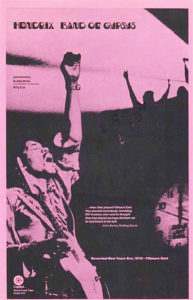
The release of Band of Gypsys in 1970 saw two promotional poster variations: the full color iteration reproduced in the “Special 50th Anniversary Edition” and this less-expensive-to-produce single-color printing on uncoated paper stock. Both inexplicably used a photograph of Jimi in a performance at the opposite end of the country from Fillmore East.
For additional perspective on this Band of Gypsys release, I’d like to introduce Gordon Johnson. Gord operates the ever-expanding JMHVINYL reference website, and has become an authority on all aspects of the music of Jimi Hendrix as released on vinyl. And believe me, that can be another tangled web! I have asked Gord to weigh in with his thoughts about the emergence of this new iteration of Band of Gypsys:
“There was some concern, from me at least, that this title may have been buried by the recent Songs for Groovy Children CD and LP sets. But now, after such a huge four-show [near complete] box set, with Band of Gypsys we get to hear just how good a snapshot these performances were.
“It is important to have this title remain available as it is amongst the last material Jimi Hendrix worked on for release and remains the very last album he actually signed off on. This re-issue vinyl is the same mix as those from 1970 and also from the plates produced for the 1997 release which [the late, great] George Marino and Eddie Kramer mastered at Sterling Sound in New York City. Those original 1997 plates firmly place this album back into the ‘All Analogue’ domain.
“The 1997 plates have produced a number of reissued records over the last near quarter of a century, from MCA to Classic Records [both in collaboration with Capitol and Experience Hendrix]. Classic actually brought us two releases: on 180-gram vinyl in 1997, and in 2005 a 200-gram pressing.
“This record also exists as an unissued Clarity record, again from Classic Records, that was pressed circa 2005.
“This is as close to an Ultra High Quality Record as we will find right now. The main difference with this pressing from earlier ones is that this is from Quality Record Pressings, while the earlier Classic release was pressed at Record Technology Incorporated. A new stamper will make a little difference but QRP seem to press better than RTI ever did. My Are You Experienced from QRP beats the RTI hands down.”
As Gord noted, Band of Gypsys is a direct connection to the creative sensibilities of Jimi himself. Unlike all the releases bearing edited Jimi Hendrix material since his death in 1970, this album isn’t what someone thinks Jimi would have wanted – it actually is what Jimi wanted. It’s what he wanted us to hear, in the way he wanted us to hear it.
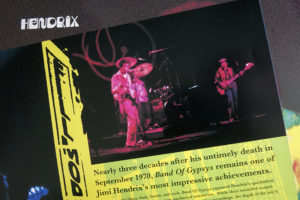
Do the math – better make that text read “five decades”…
The booklet included in the 2020 Band of Gypsys is almost identical to the one encountered in the original Experience Hendrix/Capitol editions. “Nearly three decades after his untimely death in September 1970,” John McDermott’s essay begins – quickly highlighting the fact that this content itself was generated more than two decades ago. Dimensionally the new booklet is roughly an inch larger than the original, but the interiors are nearly identical. Any variations are very minor – for example, the first double-page spread of the booklet originally included a small depiction of Jimi rendered in bright yellow, which now appears in fuchsia. Why that change became a priority I can’t imagine…
New to this set is a 24” x 36” facsimile of an original Capitol Records promotional poster from the initial release of Band of Gypsys. The poster reproduces the album’s inner-spread art work – a balcony audience at the Fillmore and a clock (with Joshua Light Show markings) on the verge of striking midnight – yet reversed in orientation and oddly juxtaposed with a photo of Jimi, arm raised, performing during a 1968 concert in Oakland, California. At the time, surely few people knew what Jimi had actually looked like on stage during the Band of Gypsys shows, but now in this age of information the use of the Oakland image looks like a lazy gaffe.
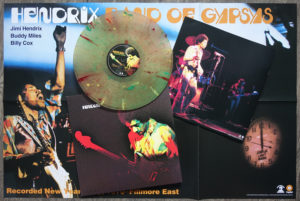
The complete U.S. 2020 “Special 50th Anniversary Edition” – including the limited-edition color vinyl pressing – of one of Jimi Hendrix’s greatest albums, Band of Gypsys.
Of course, the main focus should be on how this record sounds. Promising news came in advance when the initial February 2020 Experience Hendrix press release announced, “This new, all analog edition of Band of Gypsys has been mastered from the original analog stereo tapes…” The press release further promised an audiophile-friendly, hefty 180-gram pressing from QRP, distributed in black for general release yet available in a wildly vibrant color edition exclusively through the merchandising outlet of Experience Hendrix.
Bottom line: The sound of this new U.S. edition is simply magnificent, enveloping the listener in a riveting embrace of sound. Indeed, this whole album sounds fantastic. And is it any surprise that “Machine Gun” in particular stuns anew? This pressing fully allows the song to boldly stake its claim as the creative apex of Jimi Hendrix’s electric guitar mastery.
But wait, there’s more: late in the game came word that Experience Hendrix and Sony/Legacy were teaming up for a 50th anniversary Band of Gypsys for the European market, similar to their partnership with Capitol in the United States.
Finally shipping in early June 2020, this edition varies in that it is only available in color vinyl, the pressing palette this time consisting of red, black, and white in a marbled pattern. The decades-old booklet content is identical to that of the recent United States release, visually varying only through the use of a cleaner, lighter font. The promotional poster reproduction is missing in action – not entirely surprising given that Sony/Legacy was likely not too keen on the idea of promoting Capitol, a rival label.
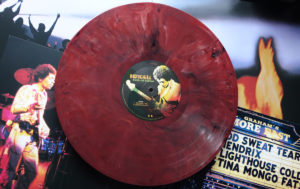
Certainly the murky color tones of this pressing more appropriately match the darkness and conflict at the heart of Jimi’s masterpiece, “Machine Gun.”
This European Band of Gypsys is from a different pressing source than the United States predecessor, and accordingly offers a somewhat different sonic perspective. Where the earlier version had an open, live feel, this pressing feels more “distinct,” with each instrument sonically regulated into its own precise location in the stereo panorama. It’s not an unpleasant listening experience by any means, simply a different one.
Ongoing comparisons of both of these pressings will do nicely to kill time until the inevitable 75th anniversary Band of Gypsys albums emerge.
THE LAST WORD – STILL THERE’LL BE MORE
Having covered Songs for Groovy Children in both CD and LP formats as well as the new Band of Gypsys in its customary vinyl album format, all that’s missing is a vinyl single. Fear not.
A final punctuation on the Band of Gypsys resurgence into the commercial music marketplace was announced early in February 2020, consisting of a limited-edition vinyl single. The record was scheduled to be released as part of the spring 2020 edition of the Record Store Day event. Record Store Day is intended to drive customers to independent record stores – or sadly, eBay, as the case may be – in search of such special items. But this Band of Gypsys single – and Record Store Day itself – was soon unscheduled by the global pandemic. It will now be some months from the time I write these words in April 2020 before “Message to Love” backed with “Changes” – pressed on yet more color vinyl – finally sees release.
Oddly, this song combination has, in fact, seen release before. As highly regarded Jimi Hendrix historian Ken Voss quickly assessed upon hearing news of this Record Store Day special: “Ironically, this is not the first time a single with these two tracks has been released. In 1970, the French Barclay label put out a series of singles titled Jimi Hendrix Story with volume five of the series including the two tracks. And checking track times, both singles as well as the album versions track in at exactly the same time.”
In other words – like so many releases targeting Jimi Hendrix’s fertile Band of Gypsys era – everything old is new again.
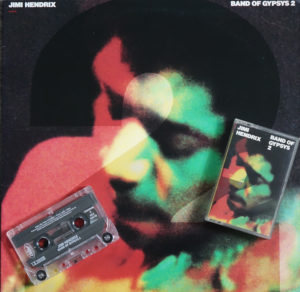
This artifact from 1986 clearly advertises itself as a “Band of Gypsys” release – but that’s only half-true. Within the pages of “Modern Listener Guide: Jimi Hendrix” you’ll find the full road map through this album and the entire tangled but brilliant legacy of Jimi Hendrix.
Perhaps the most pressing question in the wake of Songs for Groovy Children, the new Band of Gypsys, the Record Store Day release, and the Band of Gypsys Fillmore East releases that preceded them is this: Will Experience Hendrix take on a “50th Anniversary Special Edition” of Band of Gypsys 2, complete with all of its bizarre variations and misprints? We’ll just have to wait until 2036 to find out…
FOR FURTHER INFORMATION:
Jimpress: www.jimpress.co.uk
JMHVINYL (James Marshall Hendrix Vinyl): www.jmhvinyl.co.uk
Jimi Hendrix Information Management Institute: https://www.facebook.com/groups/251427364936379/
